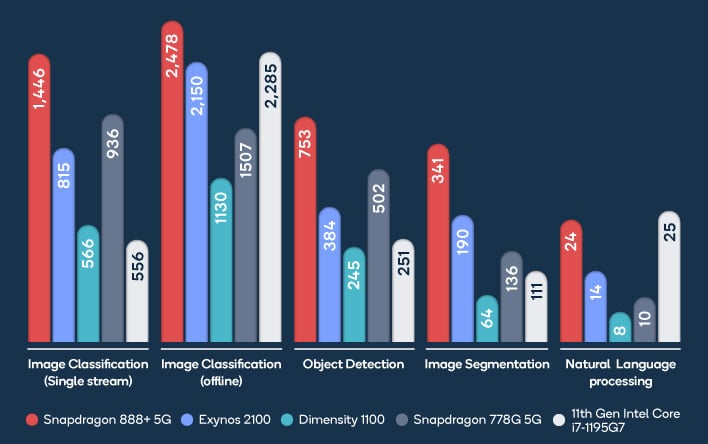Qualcomm Flexes Snapdragon's Own AI Processing Muscle In Latest MLPerf Update

There's quite a bit of moving and shaking in the chip industry right now—Apple just unveiled its M1 Max and M1 Pro chips, Google provided more details on its upcoming Tensor SoC, and of course Intel's Alder Lake launch looms right around the corner. But as it applies to the mobile space, Qualcomm has a message for the competition—Snapdragon is still a formidable architecture. To highlight the point, Qualcomm today is pointing to an updated set of MLPer results.
"There’s only one way to say it: the Snapdragon 888+ 5G Mobile Platform blew away the competition in the latest MLPerf Mobile Inference v1.1 benchmark submissions," Qualcomm begins its blog post on the results. "In one assessment that tested Image Classification (single stream), Snapdragon topped the nearest non-Snapdragon competitor by more than 40 percent."
MLPerf is a set of benchmarks by MLCommons, an open engineering consortium 0formed several years ago. It was just last month when NVIDIA leaned on MLPerf figures to highlight how competitive its A100 machine learning accelerator could be in the AI field, regardless of whether they get paired with Arm silicon or x86 hardware.
Now Qualcomm is up to bat with updated figures from MLPerf Mobile Inference, which is a full system benchmark suite that measures the processing performance of AI workloads common to smartphones. As today's handhelds become more powerful and feature-rich, developers and manufacturers are pushing the envelope on what they can do, and AI has emerged as a big part of those efforts. That's what makes MLPer Mobile Inference a valid and relevant gauge.
Let's have a look at the results...

Source: Qualcomm and MLPerf
It's almost a clean sweep across the board—the only benchmark the Snapdragon 888+ didn't dominate the playing field was Natural Language processing, and even there it beat out all but Intel's Core i7-1195G7 laptop processor, which it virtually tied instead.
In every other benchmark—Image Classification (both single stream and offline), Object Detection, and Image Segmentation—the Snapdragon 888+ raced to the front of the pack, leaving all other comers in the dust. That includes Samsung's Exynos 2100 processor.
The Exynos chip is an especially interesting comparison, because rumor has it that Google's Tensor SoC is a sort of hybrid variant of that part. Google shared a few details about the chip, saying it wields a 2+2+4 CPU core configuration, along with a 20-core GPU and various other bits aimed at bolstering machine learning workloads. But we won't know how it performs until the Pixel 6 Pro and Pixel 6 ship out.
It's quite possible that Qualcomm's Snapdragon 888+ will maintain is lead in this benchmark suite, hence today's chest-thumping. Or perhaps Qualcomm wanted to get ahead of Tensor's release, if it knows something the rest of us aren't privy to. Time will tell.
Either way, it is important to remember that these are just current Snapdragon 888+ numbers, and not what is in the pipeline. Qualcomm will typically unveil a new flagship SoC towards the end of each calendar at the Snapdragon Tech Summit, followed by shipments early the next year. So even if Tensor brings the boom, Qualcomm is likely to have upgraded silicon in retail hardware in early 2022, to either regain the lead (if it comes to that) or reiterate its performance advantage for mobile AI workloads.

